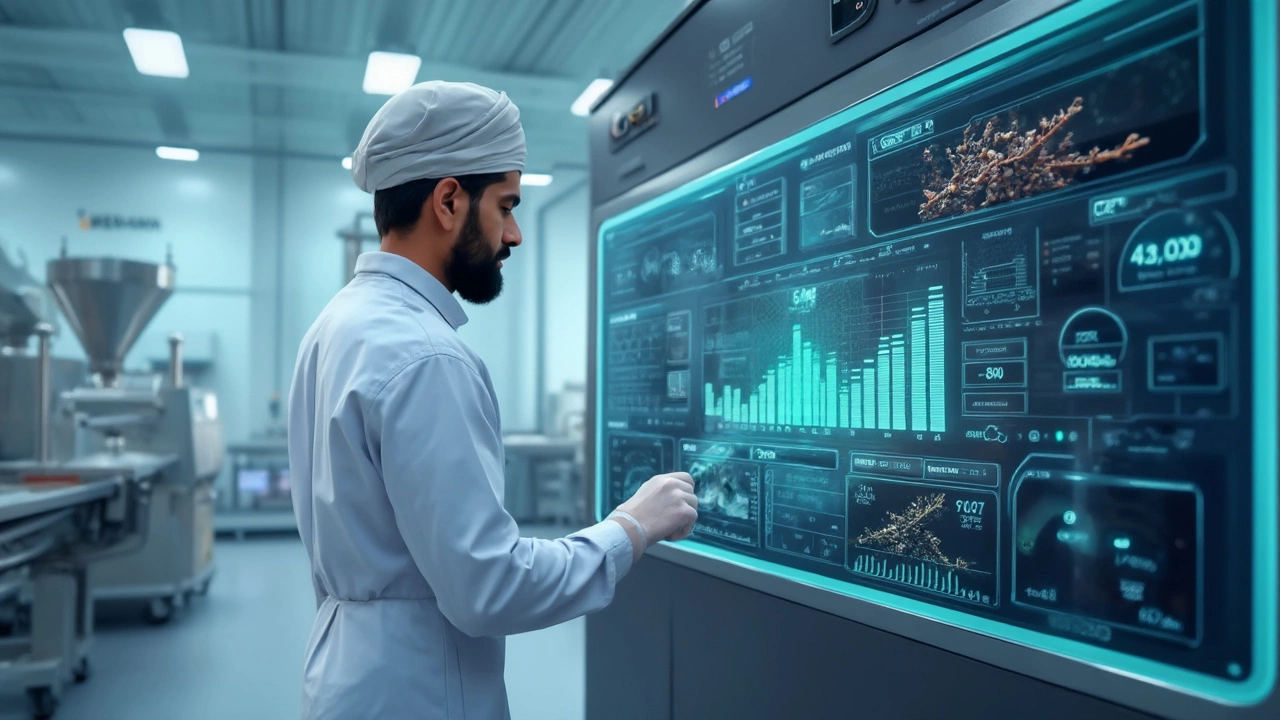If you’ve spent any time around food processing equipment, you’ve probably heard people say “CPU” when they talk about the brains running the show. But here’s a surprise—no one really calls it just ‘CPU’ anymore. The industry’s moved on, and the way we talk about these systems has changed too.
Factories today are full of high-tech machines. Instead of a simple CPU, you’ll find names like ‘PLC’ (that’s Programmable Logic Controller), ‘industrial controller,’ or ‘automation control unit’ popping up on specs and sales sheets. So if you’re still searching for CPUs for your food plant, you might be looking right past what you actually need.
The reason? CPUs are just one chip on a board. But in food processing, you need more than that. You want a whole system—something tough, reliable, and built for sticky, wet, or dusty environments. The newest control units run complicated recipes, keep your products safe from contamination, and help your operators fix problems fast. They’re smarter, safer, and make your job easier every day.
- The Old-School CPU: What Was It?
- It’s Not Just ‘CPU’ Anymore
- What’s Inside a Food Processing Control System?
- Why the Shift—And What Does It Mean for You?
- Tips for Choosing Modern Control Units
The Old-School CPU: What Was It?
Back in the day, when folks talked about a food processing unit’s brains, they meant the CPU—the Central Processing Unit. This was basically a chip or a board that did all the “thinking” for machines on the floor. In the early days of automation, CPUs were taken straight out of desktop computers and adapted to run mixers, packagers, and conveyor belts. The idea was simple: give the equipment some smarts, let it follow programmed instructions, and boom—productivity went up.
These CPUs handled basic stuff like:
- Turning machines on and off at the right time
- Regulating temperature and pressure
- Making sure ingredients mixed for the right amount of time
- Sending alerts if anything broke
But these early systems were pretty limited. They ran on fixed programming—nothing fancy, no teachable skills, and zero flexibility. If you wanted to change a recipe or add a new product, you were cracking open panels, pulling out chips, and sometimes calling in a tech for a full software rewrite. Not exactly plug and play.
One thing people don’t always realize: CPUs in food plants had to be tougher than in office computers. They needed to deal with wet floors, steam, and jostling. Older CPUs didn’t have built-in safety features for food, so if a chip failed, it could mean lost batches or even safety recalls.
For reference, here’s a quick table showing what old-school CPUs did compared to modern controllers:
| Feature | Old-School CPU | Modern Control Unit |
|---|---|---|
| Flexibility | Low—fixed programming | High—easy reprogramming |
| Safety Features | Basic alarms | Integrated food safety |
| Connectivity | Stand-alone or limited network | Full plant integration, remote monitoring |
| Ease of Upgrades | Difficult, sometimes manual hardware swaps | Software updates and modular add-ons |
It’s Not Just ‘CPU’ Anymore
These days, when you look inside a food processing unit, you rarely see the word “CPU” on the main control gear. Sure, every electronic brain has a CPU chip—just like your phone or laptop. But in the food industry, the gear that pulls everything together goes by other names now.
You’ll most often run into terms like Programmable Logic Controller (PLC), industrial computer, or automation controller. A CPU is just one part inside these units—like the engine inside a car—but the whole “car” is what actually runs your production line.
PLCs are the main choice in most factories. Why? They’re tough, simple to program for factory workflows, and built to keep running when everything else gets messy. Unlike regular computers, PLCs won’t flinch at high humidity, water splashes, or random power flips—pretty important if you’re running a line for bread, mixing sauces, or blasting frozen snacks all day.
Manufacturers like Siemens, Allen-Bradley, and Schneider are big players in this space. Their control systems can handle thousands of sensors and switches, and some models even connect straight to cloud platforms for remote monitoring or recipe changes. Fun fact—over 85% of large food plants in the US use some form of PLC or industrial controller on every major line.
Here’s a quick breakdown of what you might see on modern food equipment:
- PLC (Programmable Logic Controller): Handles tasks like timing, mixing, and general machine control. Easy to reprogram when you want to tweak recipes or batch sizes.
- HMI (Human-Machine Interface): The touchscreen or button panel operators actually use.
- SCADA (Supervisory Control and Data Acquisition): Bigger plants use these for data logging, alarms, and remote plant management. Think of it as mission control for your whole operation.
So, next time you’re checking out a new processing line, skip the term ‘CPU’ and pay attention to what sort of PLC or automation system is running under the hood. That’s the name that actually matters now in modern food manufacturing.

What’s Inside a Food Processing Control System?
Pop open the cabinet of a modern food processing line, and you’ll spot way more than just one chip or board. These systems are mini command centers. The star has shifted from the old-school CPU to robust programmable logic controllers (PLCs), industrial PCs, and smart modules that work together to keep things moving and safe.
Here’s what you typically find inside a food processing control system:
- PLC or Industrial PC: This is the main controller running the entire operation—think of it as the traffic cop making sure every task is done at the right time. Unlike basic CPUs, PLCs are built to survive hot, cold, wet, and sticky conditions common in food plants.
- Input/Output (I/O) Modules: These handle the real-world signals from sensors (like temperature or weight) and control things like motors, pumps, or conveyor belts.
- HMI Screens (Human-Machine Interfaces): These touchscreen panels or computers let your staff see what’s happening and tweak settings without climbing inside a panel.
- Communication Modules: A food processing plant is full of machines talking to each other. Modules using Ethernet, Profibus, or Modbus connect everything for smooth data flow.
- Power Supplies: Reliable, filtered power is a must. You’ll find dedicated supplies to keep the system safe—even during a power glitch.
- Safety Relays and Emergency Circuits: Because safety in food processing is not negotiable, expect hard-wired circuits and relays that can shut down equipment in milliseconds if anything goes wrong.
Want the full picture? Check out this quick breakdown from a typical setup:
| Component | Main Job |
|---|---|
| PLC | Controls the process, runs programs |
| I/O Modules | Collect information and trigger actions |
| HMI | User interface to monitor and adjust |
| Power Supply | Keeps it all running, even during surges |
| Communication | Data transfer between systems |
| Safety Relays | Protects people and equipment |
One important shift: food processing units can now store huge amounts of recipe data, monitor hygiene cycles, and provide maintenance alerts. With all these parts working together, today’s food processing control units do a whole lot more than the old CPU ever could.
Why the Shift—And What Does It Mean for You?
The main reason for steering away from calling control units just "CPU" is how much food processing technology has changed. Back when everything was mostly mechanical, a simple CPU was enough. Now, there’s a ton more tech packed in—sensors, smart controls, safety locks, and real-time data crunching. So instead of one chip running the show, you have automation systems leading whole lines of machines.
PLCs and industrial controllers can handle recipes, track food safety steps, and manage alarms all at once. That’s a huge step up. They’ve built in things like waterproof casings, easy-to-wash surfaces, and backup systems, which are must-haves for food factories. You’re not just running a machine; you’re making sure every burger patty or cookie meets the same standard, every single time.
Here's what that means for your everyday work:
- You can set up new products or tweak recipes on the fly, just using a touchscreen.
- Data tracking is automatic, so compliance with food safety laws gets way simpler.
- If a machine's about to go down, modern controls send alerts so you can fix it before things grind to a halt.
Just to put things in perspective, a 2023 survey by Food Engineering magazine found that over 70% of new food plants chose PLC-based controls over basic CPUs for automation. The trend is crystal clear—more control, more safety, less hassle.
| Feature | Classic CPU | Modern Control Unit |
|---|---|---|
| Food Safety Features | None | Built-in |
| Customization | Very Limited | Flexible/Programmable |
| Data Logging | Manual/External | Automatic |
| Downtime Alerts | No | Yes |
The takeaway? Knowing the new terms and what they actually do will help you keep your production lines safer, future-proof your investments, and keep the whole operation running smoother.

Tips for Choosing Modern Control Units
Shopping for a new control system for your food processing setup isn’t something you want to rush. The choices you make can keep your lines running smooth—or leave you dealing with endless headaches. If you’re comparing options, here’s what actually matters for today’s food processing world.
- Go For Ruggedness: Industrial environments are messy. Moisture, dust, and temperature swings come with the territory. Look for units with good ingress protection (IP ratings like IP67 or IP69K mean they can take serious cleaning or splashes without dying on you).
- Think About Compliance: Food safety rules aren’t getting any lighter. Make sure your controller meets global standards, like FDA or USDA approval, and is easy to clean. Stainless steel housings are a plus.
- Easy to Use Means Less Downtime: Fancy isn’t better if nobody knows how to use it. Choose a control unit with a simple interface and clear diagnostics. Bonus points if your team can get quick training from the manufacturer.
- Don’t Guess on Connectivity: Can it talk to your other machines and your software? Ethernet/IP, MODBUS, and ProfiNet support make mixing old and new equipment a lot simpler.
- Think Scale: Sure, you may run one line today—what about next year? Systems that can easily scale up (add cameras, sensors, or new lines) save you a headache and cost later.
Here’s a quick look at what most buyers care about when picking a control unit:
| Feature | Why It Matters |
|---|---|
| Ingress Protection (IP65+) | Handles water and dust; lasts longer on the plant floor |
| Global Compliance | Keeps you out of trouble with inspectors |
| Modular Design | Easy and cheap to upgrade |
| User-Friendly Interface | Less training, fewer mistakes |
| Multiple Network Support | Connects with new and legacy equipment |
If you’re on the fence about a particular system, check if the supplier offers demo units or a trial period. And always ask about local support—those calls at 2 a.m. hit different when your whole line is stuck.









Write a comment